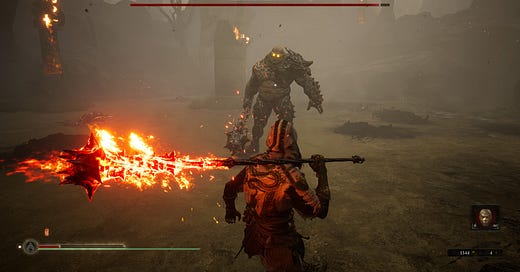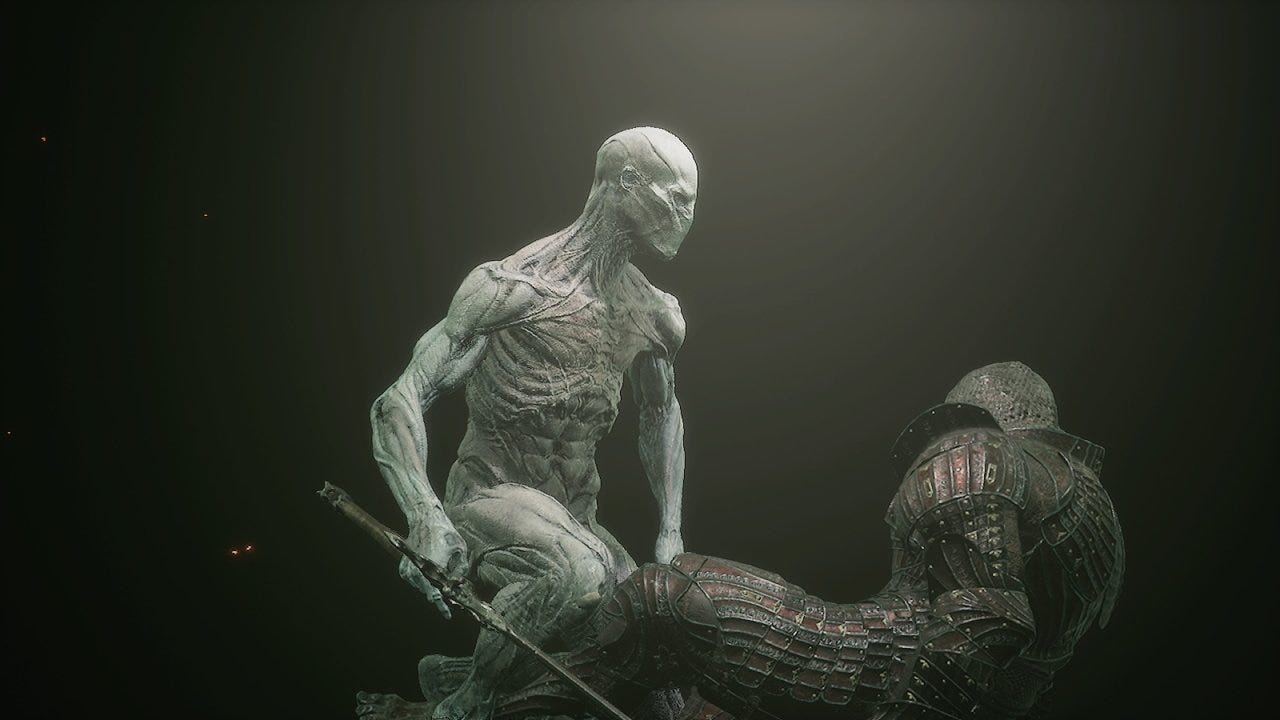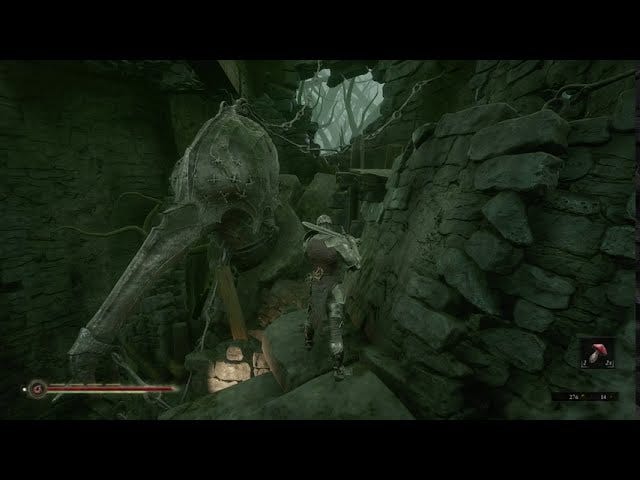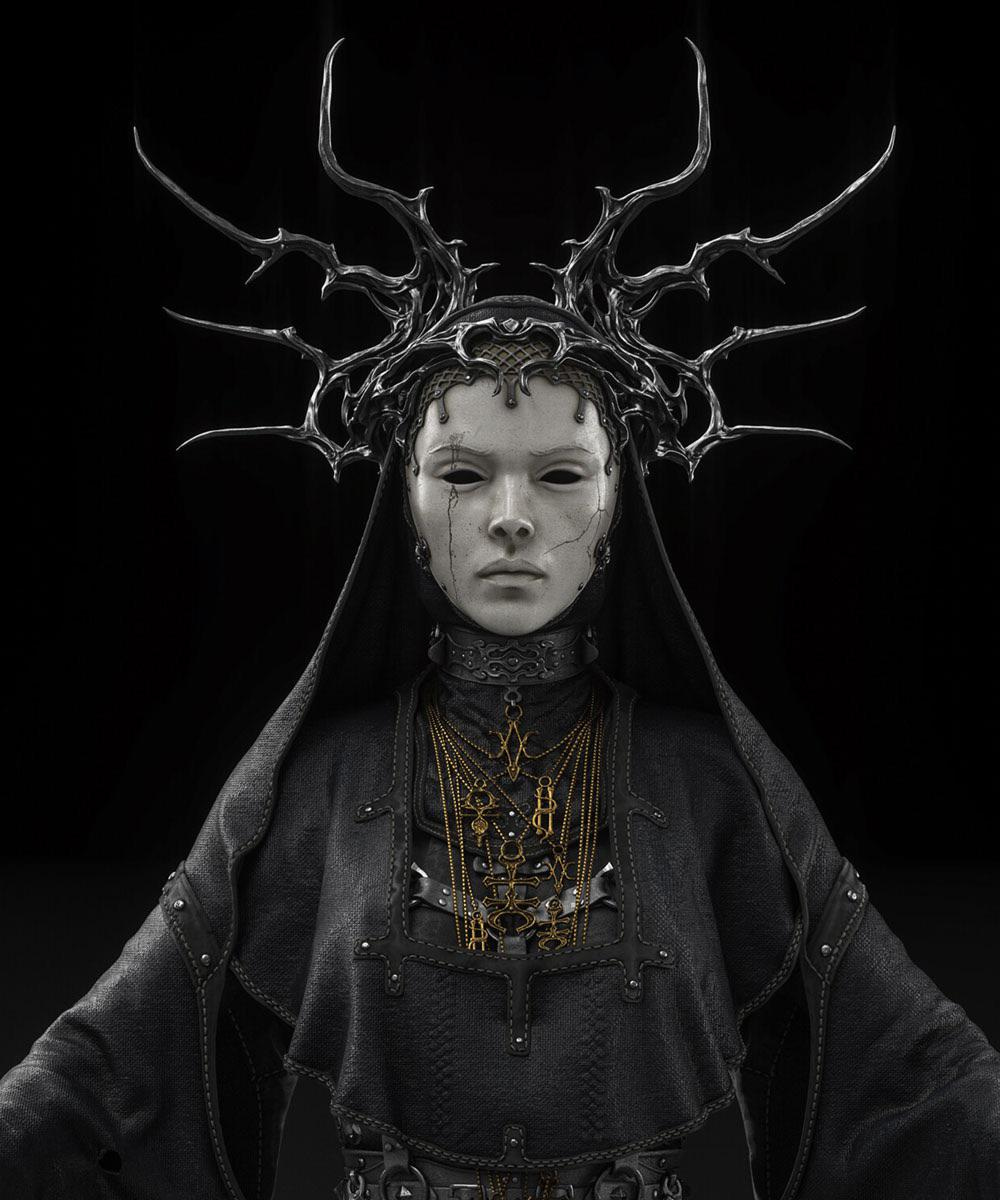This piece has taken longer to finish because of my work schedule and an overwhelming sense of despair, both of which makes writing about Video Games more difficult. I know that I care about the games I’m writing about but in the face of overwhelming despair, it gets harder to write these pieces. And I wish I could say that my despair has some nobility about it but it’s very self-interested. Nevertheless, I attempt to persist because I don’t know what else to do but try and keep creating.
Today we’re going to be looking at “Mortal Shell”, an indie souls-like with triple AAA gloss that has unjustly taken a bit of a critical beating as of late.
Mortal Shell
A unique Souls-like wrongly seen as rote and generic.
“Mortal Shell”, a Souls-like from indie developer Cold Symmetry has an intriguing focus on body swapping.
Body swapping is nothing new to Souls-likes and especially those from Fromsoft. Besides the notorious gender-swapping coffin in “Dark Souls 2”, the way your character’s gender is presented is dependent largely on their armor set.
I was playing Dark Souls 3 and my friend Allie was surprised to see me playing as a man. “Oh no”, I said “she’s a woman…” but when I looked at my character, there was no way of telling she was female. In all of the “Dark Souls” games, different armor sets seem to shift your character’s identity and physicality.
I think this decision dates back to Fromsoft’s roots as a Mecha (Japanese genre about giant robots) studio making games such as “Armored Core”. In “Armored Core” different Mech designs are believed to express the player’s personality. Similarly, in the “Dark Souls” games, the various armor sets express physicality and personality more than the character models which up until “Elden Ring” were fairly basic.
“Mortal Shell” might have been inspired by this to make the body-swapping literal. The protagonist, the Founding is a sort of fragile parasite that inhabits the corpses of various undead warriors. Because of this, there is no need for a “build” (what RPG fans call an ideal arrangement of stats). Each different armored shell (i.e.: corpse) you inhabit is its own build. You start out by possessing Harros the Vassal, a generic but solid shell who is average in all stats. You can quickly inhabit Solomon the Scholar, who excels in parrying and has a slightly bigger health bar. By the endgame, you can get Tiel the Acolyte, a high stamina glass cannon who can dodge forever but can barely survive one hit. Or Eredim the Venerable who has a very long health bar with very low stamina. While each of the characters are improved with “tar” (the games experience points and currency), there’s not really a possibility of overlevelling them, just a gradual power curve.
This improvement is explained as your character gaining familiarity with each of the shells it inhabits. This familiarity is also shown by getting backstory from each shell, narrated in their own voice. These voice-overs are extremely varied in quality, but I loved the voice-over of Solomon who has an American accent and sounds like a humanities professor who recorded his lines while on sabbatical.
We can see already from the way the game approaches builds that people’s perceptions of “Mortal Shell” are inaccurate. There’s a misconception that “Mortal Shell” is a kind of generic offering comparable to the original “Lords of the Fallen”. The reality is Mortal Shell is a Souls-like that goes out of its way to approach the mechanics and style of its genre in an esoteric way.
Another example of this offbeat approach is the unfortunately named “hardening” mechanic of the game. As part of the Foundling’s abilities, you are able to change the consistency of your shells to that of a statue. You can harden your shell for an unlimited amount of time and take about two hits. You can do this whenever but hardening at the correct time will stagger an attacking enemy and damage them slightly.
What makes this mechanic interesting especially is that it disrupts a common mechanic for Souls games, blocking. Rather than doing a correctly timed block and then counter attacking, you can attack while hardening. You can even start an attack, harden, and then let the enemy attack you and get staggered and then finish your attack. The rhythm of attacking is a lot different than other Souls games.
This is also part of why Mortal Shell has been dismissed by a lot of Souls fans, they approach it as a typical Souls-like and get frustrated when that approach doesn’t work. At times Mortal Shell can be a janky game, but some have seen the unique mechanics as further jank rather than the developers deliberately innovating.
(On a side note: it seems no one knows where the modern usage of janky for games came from. Apparently it’s roots are Scottish?)
An innovation that doesn’t work as well is the “resolve” system. Basically, your character has a bar which gradually fills up through successful combat that allows them to do special attacks. What makes this frustrating is that this bar is tied to your ability to parry and riposte attacks.
Parrying in Fromsoft games usually had some measure of controversy attached to it. In “Dark Souls 1” and “Demon Souls”, it was something of a hidden mechanic. Most players didn’t use it so it was incredibly easy to parry most enemies and most difficult enemies could be trivialized by parrying them. In later Fromsoft games, parrying was better known so Fromsoft made it more difficult, varying the timing and when on the windup of an attack the parry could be done correctly. In some sense, this improved the parrying experience, but it also made the mechanic feel overly finicky to some.
“Mortal Shell” has the same difficult timing as Fromsoft and then adds to the difficulty.
A successful parry feels like a reward for mastering the timing of an enemy attack. This is why having to spend in-game currency as well feels like the game is setting too high a price on this reward.
Another mechanic which is interesting but not as impactful is how the game handles consumables, when you first find a consumable, you’ll get the name of it but no information on what it does. Your character needs to familiarize themselves with the consumable to know what it does but also to derive the most benefit from it. This is especially notable with the Wellcap mushrooms you pick up, which heal you more the more familiarity you have and the Tarspore mushrooms which at first only poison you but as you gain immunity begin to act as an antidote. While this is cool, my character maxed out it’s familiarity with most of the items quite early in my playthrough, so I quickly stopped noticing the mechanic.
While the story in Mortal Shell is as traditionally cryptic as a Souls game, there are many nice innovative touches within it.
While the story follows fairly closely to the Soul’s cliché of a mysterious quest giver asking you to complete a quest with an ambiguous intent. The Prisoner, a large pachyderm wearing a hooded mask, gives you your parry tool after you free him and asks you to retrieve sacred glands from three different temples in the surrounding marsh of Fallgrim. There’s never any explanation of what befell the surrounding area, but it seems that civilization has either never really gotten started or collapsed. What organization there is besides the masked bandits is inside the temples where different sects have dedicated themselves to various mortifications around their deities. You need to kill these deities and harvest their sacred organs and return them to the prisoner.
It's particularly within the temples that the game begins to shine. This is slightly unfortunate because the opening area of Fallgrim suffers a bit from a bit of blandness with its repeated enemies and its confusing layout. It’s a common mistake of many indie soulslike titles to not have a map but generally the same studios also lack Fromsoft’s ability to make areas look instantly recognizable from the moment you see them. The initial area is incredibly confusing which is not helped by an intertitle reading “Fallgrim outskirts” which appears whenever you get near any of the three dungeons. It would have helped tremendously if this intertitle was unique for each area.
Yesterday, I played alongside an online map and still managed to get completely lost several times. It’s too bad that “Mortal Shell” is going to start off by giving people a bad impression.
Once you’re inside each of the dungeons, the game gets more of its unique dark fantasy style. From the icy Crypt of Martyrs to psychedelic Eternal Narthex, each area has something interesting about and some of the cooler enemies. One of my favorite enemies are in the Crypt of Martyrs, the Slave of Scorn is a cenobite like creature who attacks you with swords plucked out of their own body and when you do enough damage to them, they rip off their own head and throw it at you. Another great enemy is in the Eternal Narthex, a group of female assassins who look like a superhero team who attack with crossbows and rapiers and shriek as they attack.
In my earlier review of “Immortal Unchained” I discussed my love of action figures especially those in heavy armor. The enemies in “Mortal Shell” feel like some of the coolest action figures a child could own while being too gruesome for that purpose.
You are aided by Sester Genessa who has a bit more personality than the typical firekeeper. There is no reason why she aides you and converts your tar into knowledge with your shell but this we can ignore as she is also a more memorable character. She apparently is some sort of mystic who has figured out what none of the sects in the game cannot, how to transcend her body and exists in a spectral form. One of the shells you discover Tiel was apparently her partner at one point. Seeing him awakens a nostalgia for her corporeal form. Another great little touch I discovered is in one of the final areas of the game, if you engage in combat to close to her, she chuckles wryly at you as if the macho swordplay of your character is a childish game that she no longer has to deal with. Altogether, Sester Genessa has the kind of depth of the Emerald Herald in “Dark Souls 2”.
(spoilers start next paragraph)
The game ultimately climaxes when you return the last and most difficult to obtain of the organs to the Prisoner. The Prisoner reveals his true colors by attacking you and stealing the organs from you. When you return to confront him, you discover him raging inside of his arena. He has discovered that the three sacred glands can do nothing to free him from his ultimate mortality. It seems this knowledge has driven him insane.
He realizes that only the Foundling can be freed from this mortal realm, so he seeks to destroy you. He sends wave of wave of other shells to destroy you, perhaps implying that you are his creation. He may have created the Foundling but that his creation is free from mortality in a way that he is not. In fact, when you destroy him, you harvest his sacred organ and begin to levitate above the world.
So, if “Mortal Shell” has all these unique features, why is it seen as a mediocre Soulslike by a lot of people in the community? Part of it is the marketing not being great, but I think there’s other reasons that hold it back.
Cold Symmetry (the developers behind “Mortal Shell”) is notably a very small team of talented industry veterans, so the game looks beautiful, but it plays jankier than you expect. There’s a dissonance between the high gloss of the graphics and the jank of the way your character interacts with environments. In a game where you spend a lot of time backing away to try to draw individual enemies into winnable encounters, there is an unfortunate tendency of your character to get stuck on random bits of scenery.
Lock-on combat can be disrupted by bad pathfinding and camera movement, something that early Fromsoft titles tended to have a lot more of. While the camera positioning in Moral Shell is usually spot on, there’s pathfinding issues where your character seems to clumsily maneuver over the background.
This cognitive dissonance is difficult to get over in the modern souls’ community where high gloss is everything. This combined with the games insistence on taking encounters slowly might have made it unpopular with a post-Bloodborne audience who wants their soulslikes to be not only smooth as butter but as fast as a “Devil May Cry”: game.
“Mortal Shell” focus is on blocking rather than dodging. This might also be a tick against the game. For the modern-day Souls community have taken one item description in “Bloodborne” to mean that shields and blocking are a sign of weakness. “Shields engender passivity!” they will post on subreddits as if quoting Miyazaki and not an item description.
Apparent strength is conferred by two-handing a weapon and pressing an entirely different button to roll out of enemies’ attacks. This has been compounded as well by “Dark Souls 3” in which rolling was so overpowered that blocking was unnecessary and often detrimental. All this is to say, the roll in “Mortal Shell” is present but feels clumsy and is not to be preferred over the hardening which is more reliable in this games combat system.
The combat in “Mortal Shell” also requires one to slow down, your character can hold a block forever so you can sometimes attack and then block for a long suspenseful moment as enemies approach and attack. This slowness has increasingly become out of vogue in newer soulslike titles which in my view is unfortunate. This real jank combined with a combat system that is unique and not immediately obvious created the misperception that “Mortal Shell” is a bad copy of ‘Dark Souls”.
Like other games written about in this series, “Mortal Shell” is no hidden gem as it is much too well-known, but it deserves a reevaluation as being an interesting example of trying something different in a Soulslike. It’s unfortunate that it seems that indie soulslikes are critically punished when they try something different but that is going to a theme in this series, one that will continue in our next game, “Solar Ash”.













